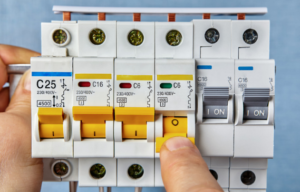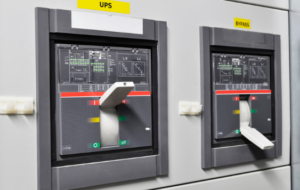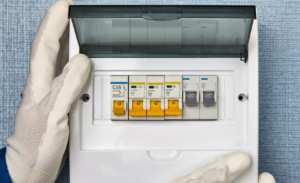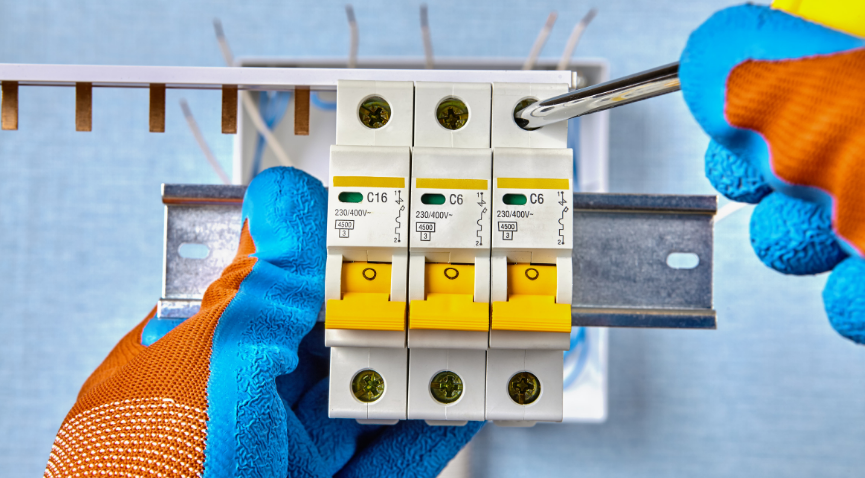Table of Contents
We can often find sudden electrical failures in homes and businesses. If not addressed promptly, these electrical failures can significantly damage the electrical infrastructure. These mishaps can even lead to devastating effects like fires in some severe cases.
Many electrical types of equipment, like surge arrestors, are in place to prevent such accidents. One such safety equipment we will cover in this blog is circuit breakers. In addition, this blog will shed light on what circuit breakers are, how they function, and their various types.
Circuit Breakers – A Brief Insight

An electrical circuit breaker is a switching mechanism that can control and protect an electrical power system manually and automatically. Because the modern power system deals with high currents, particular consideration should be made while building a circuit breaker to guarantee that it can safely stop the arc produced when a circuit breaker is closed. This is the fundamental definition of a circuit breaker.
As an example, consider a house. A major electrical circuit in a house is made up of multiple subordinate circuits. This circuit in your home is powered by electricity generated at the power plant. Electric current is regulated within safe limits or voltage limitations under typical situations. However, for various reasons, the electrical charge can sometimes exceed what a circuit can take, causing damage to the circuit and the items linked to it and creating risks of starting a fire.
This is where a circuit breaker intervenes to protect the electrical equipment. The primary function of a circuit breaker is to confirm that the electrical current does not increase the safe limits. If the electric current exceeds, immediately halt the operation of the electric circuit to avoid damage to the electrical infrastructure in general.
Circuit Breakers Types

Circuit breakers are primarily categorized based on their rated voltages. However, the most general method of circuit breaker classification is based on the medium of arc extinction.
- Air Circuit Breaker: The arc extinguishing medium of this circuit breaker is a high-pressure air blast. In the event of an incorrect flow, the blast valve opens the contact.
- SF6 Circuit Breaker: Sulfur hexafluoride is utilized as an arc extinguishing medium in SF6 circuit The sulfur hexafluoride gas gains free electrons. When the circuit contacts are opened, the gas flows through the chamber, inserting the arc.
- Vacuum Circuit Breaker: The vacuum is the arc extinguishing medium in vacuum circuit breakers. This circuit breaker has a substantially higher insulating capacity than other models. When the vacuum is opened, the ionization of the metal vapours causes an arc to occur. The vacuum chamber houses the moving and fixed contact with the arc shield.
- Oil Circuit Breakers: Oil is utilized as the arc extinguishing medium in oil circuit breakers. Once the connections in the oil are opened, the arc strikes, evaporating the surrounding oil into hydrogen gas. As a result, a hydrogen gas bubble surrounds the arc. The great thermal comfort of this hydrogen gas cools the arc and deionizes the medium.
Circuit Breakers Working Principle

A circuit breaker has two important contacts, which are: fixed contacts and moving contacts. When the circuit is closed, which is usual, the contacts contact each other and carry the current. Current-carrying contacts in a closed-circuit breaker are known as electrodes that engage each other due to the pressure of a spring.
Get in Touch with a Dependable Service Provider
Now, we are sure you have adequate understanding of circuit breaker operations and their usefulness in the protection of an electrical system. Still, it is also critical that you know how to select the most appropriate circuit breaker type based on your demands. A dependable and professional service provider can help you assess your requirements and present the best way forward.
Author Profile

- Guest Blogger & Outreach Expert - Interested in Writing Blogs, Articles in Business Niche | News Journalist By Profession in the United Kingdom
Latest entries
 BusinessNovember 21, 2025A Practical Guide to Using LMS Platforms for Better Onboarding
BusinessNovember 21, 2025A Practical Guide to Using LMS Platforms for Better Onboarding EducationNovember 17, 2025Choosing the Right AI Course for Your Child: A Parent’s Guide
EducationNovember 17, 2025Choosing the Right AI Course for Your Child: A Parent’s Guide FinanceSeptember 19, 20257 Paid Advertising Mistakes That Drain Your Marketing Budget
FinanceSeptember 19, 20257 Paid Advertising Mistakes That Drain Your Marketing Budget BusinessAugust 22, 2025How Recycled Polythene Helps Businesses Exceed Sustainability Targets?
BusinessAugust 22, 2025How Recycled Polythene Helps Businesses Exceed Sustainability Targets?





